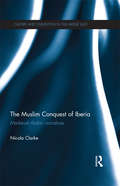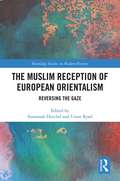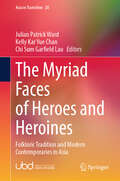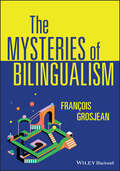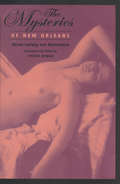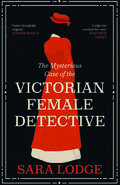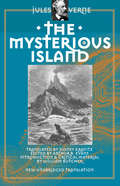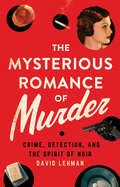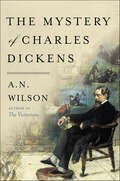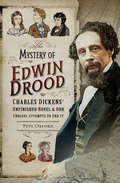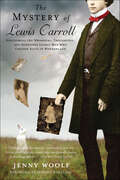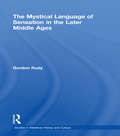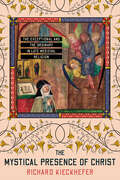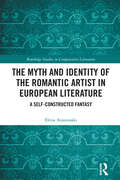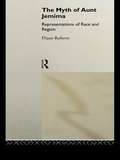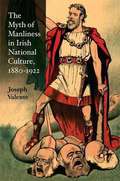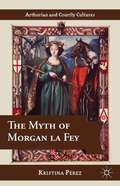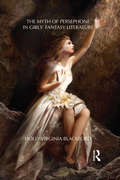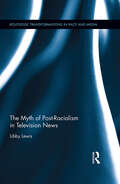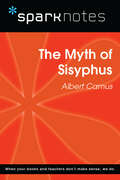- Table View
- List View
The Muslim Conquest of Iberia: Medieval Arabic Narratives (Culture and Civilization in the Middle East)
by Nicola ClarkeMedieval Islamic society set great store by the transmission of history: to edify, argue legal points, explain present conditions, offer political and religious legitimacy, and entertain. Modern scholars, too, have had much to say about the usefulness of early Islamic history-writing, although this debate has traditionally focused overwhelmingly on the central Islamic lands. This book looks instead at local and regional history-writing in Medieval Iberia. Drawing on numerous Arabic texts – historical, geographical and biographical – composed and transmitted in al-Andalus, North Africa and the Islamic east between the ninth and fourteenth centuries, Nicola Clarke offers a nuanced and detailed analysis of narratives about the eighth-century Muslim conquest of Iberia. Comparing how individual episodes, characters, and themes are treated in different texts, and how this treatment relates to intellectual debates, literary trends, and socio-political conditions at the time of writing, she shows how competing priorities shaped myriad variations on a single story and how the scholars and patrons of a corner of the Islamic world distant from Baghdad viewed their own history. Offering a framework in which historians of Christian Iberia (and of Christian Europe more generally) can approach and make sense of culturally-significant texts from Muslim Iberia, this book will also be relevant to broader debates about the historiography of early Islam. As such, it will be of great interest to scholars of historiography, world history and Islamic studies.
The Muslim Reception of European Orientalism: Reversing the Gaze (Routledge Studies in Modern History)
by Umar Ryad Susannah HeschelEdward Said’s Orientalism, now more than fifty years old, has to be one of the most frequently cited books among academics in a wide range of disciplines, and the most frequently assigned book to undergraduates at colleges. Among the common questions raised in response to Said’s book: Did scholars in Western Europe provide crucial support to the imperialist, colonialist activities of European regimes? Are their writings on Islam laden with denigrating, eroticized, distorting biases that have left an indelible impact on Western society? What is the "Orientalism" invented by Europe and what is its impact today? However, one question has been less raised (or less has been done about the question): How were the Orientalist writings of European scholars of Islam received among their Muslim contemporaries? An international team of contributors rectify this oversight in this volume.
The Myriad Faces of Heroes and Heroines: Folkloric Tradition and Modern Contemporaries in Asia (Asia in Transition #28)
by Kelly Kar Yue Chan Chi Sum Garfield Lau Julian Patrick WardThis collection scrutinizes the representation, dynamics, transformation and/or adaptation of various heroes and heroines in different folkloric traditions and narratives in the context of Asia. Exploring notions in the topics of mythologies, folktales, literature, theatre performance and any other art forms, the volume collates discussions on the pragmatic and aesthetic representation of men and women within the mythic world, and within contemporary settings. In doing so, it produces a contemporary theorization of Asian heroes and heroines beyond their mythic structure and folkloric limits. In considering the representation of heroes and heroines in the Asian folkloric tradition, and in comparative contexts, the book establishes connections between characters from myths and folktales and those found in contemporary narratives, considers the adaptation and transformation of heroes and heroines as revealed in a variety of literary works, and also assesses the gendering of social roles in modern literature and other art forms. It is of interest to scholars and advanced students in comparative literature, Asian cultural studies and theatre and performance.
The Mysteries of Bilingualism: Unresolved Issues
by François GrosjeanEleven critical issues in the study of bilingualism: Insightful analyses by renowned expert François Grosjean The majority of people living around the world today are able to speak more than one language, yet many aspects of the nature and experience of bilingualism raise unresolved questions for researchers. Who exactly is bilingual? What is the extent of bilingualism? How do infant bilinguals who acquire two languages at the same time manage to separate them? Does language processing work differently when bilinguals are interacting with monolinguals and with bilinguals? When a speaker changes their language, do they also change aspects of their personality? In The Mysteries of Bilingualism, eminent scholar François Grosjean provides a comprehensive examination of individual bilingualism that delves into unanswered questions and challenges many of the myths and misconceptions surrounding bilingualism. Through insightful analyses of eleven key questions, this book offers a unique combination of personal reflection, literature review, personal testimony, and case studies to explore these mysteries. Altogether, this text offers: Comprehensive explorations of the linguistic aspects of bilingualism, including who is bilingual, describing bilinguals, accented speech, and language loss Practical discussions of speech and language processing, including language choice and mixed speech perception and production In-depth examinations of personality and culture in relation to bilingualism and biculturalism Perfect for undergraduate and graduate students of bilingualism, multilingualism, second language acquisition, and applied linguistics, The Mysteries of Bilingualism offers an up-to-date view of the leading research questions in the study of bilingualism today.
The Mysteries of New Orleans (The Longfellow Series of American Languages and Literatures)
by Baron Ludwig von ReizensteinOne of the most scandalous books published in America in that time."Reizenstein's peculiar vision of New Orleans is worth resurrecting precisely because it crossed the boundaries of acceptable taste in nineteenth-century German America and squatted firmly on the other side... This work makes us realize how limited our notions were of what could be conceived by a fertile American imagination in the middle of the nineteenth century."—from the Introduction by Steven RowanA lost classic of America's neglected German-language literary tradition, The Mysteries of New Orleans by Baron Ludwig von Reizenstein first appeared as a serial in the Louisiana Staats-Zeitung, a New Orleans German-language newspaper, between 1854 and 1855. Inspired by the gothic "urban mysteries" serialized in France and Germany during this period, Reizenstein crafted a daring occult novel that stages a frontal assault on the ethos of the antebellum South. His plot imagines the coming of a bloody, retributive justice at the hands of Hiram the Freemason—a nightmarish, 200-year-old, proto-Nietzschean superman—for the sin of slavery. Heralded by the birth of a black messiah, the son of a mulatto prostitute and a decadent German aristocrat, this coming revolution is depicted in frankly apocalyptic terms.Yet, Reizenstein was equally concerned with setting and characters, from the mundane to the fantastic. The book is saturated with the atmosphere of nineteenth-century New Orleans, the amorous exploits of its main characters uncannily resembling those of New Orleans' leading citizens. Also of note is the author's progressively matter-of-fact portrait of the lesbian romance between his novel's only sympathetic characters, Claudine and Orleana. This edition marks the first time that The Mysteries of New Orleans has been translated into English and proves that 150 years later, this vast, strange, and important novel remains as compelling as ever.
The Mysterious Case of the Victorian Female Detective
by Sara LodgeA revelatory history of the women who brought Victorian criminals to account—and how they became a cultural sensation From Wilkie Collins to the adventures of Sherlock Holmes, the traditional image of the Victorian detective is male. Few people realise that women detectives successfully investigated Victorian Britain, working both with the police and for private agencies, which they sometimes managed themselves. Sara Lodge recovers these forgotten women&’s lives. She also reveals the sensational role played by the fantasy female detective in Victorian melodrama and popular fiction, enthralling a public who relished the spectacle of a cross-dressing, fist-swinging heroine who got the better of love rats, burglars, and murderers alike. How did the morally ambiguous work of real women detectives, sometimes paid to betray their fellow women, compare with the exploits of their fictional counterparts, who always save the day? Lodge&’s book takes us into the murky underworld of Victorian society on both sides of the Atlantic, revealing the female detective as both an unacknowledged labourer and a feminist icon.
The Mysterious Correspondent: New Stories
by Marcel Proust'Startlingly audacious.' Literary Review New writing from the literary master Throughout Proust&’s life, nine of his short stories remained unseen – the writer never even spoke of them. Perhaps he was not ready to share the early themes he was nurturing for his masterpiece, In Search of Lost Time. Or perhaps, in dealing directly with gay desire, they were too audacious – too near to life – for the censorious society of the time. In these stories, published in English for the first time, we find an intimate portrait of a young author full of darkness, complexity and melancholy, longing to reveal himself to the world.
The Mysterious Island: The Secret Of The Island (Early Classics of Science Fiction)
by Jules VerneAt a time when Verne is making a comeback in the US as a mainstream literary figure, Wesleyan is pleased to publish a new translation of one of his best-known novels, The Mysterious Island. Although several editions under the same title are in print, most reproduce a bowdlerized nineteenth-century translation which changes the names of the characters, omits several important scenes, and ideologically censors Verne's original text.The Mysterious Island was published in 1874, and it is one of Verne's longest novels. The plot depicts a group of men who have become castaways stranded on an island in the Pacific during the American Civil War. The novel describes their attempts not only to survive but also, with the aid of the scientific and technological know-how, to rebuild their world from the meager resources of the island. At the end, however, it is realized that Captain Nemo, from Twenty Thousand Leagues Under the Sea, has secretly been helping the settlers. A marvelous adventure story, The Mysterious Island is also notable for its modern retelling of the utopian deserted-island myth, with repeated echoes of Robinson Crusoe and the Swiss Family Robinson. This Wesleyan edition features notes, appendices and an introduction by Verne scholar William Butcher, as well as reproductions of the illustrations from the original French edition.
The Mysterious Romance of Murder: Crime, Detection, and the Spirit of Noir
by David LehmanFrom Sherlock Holmes to Sam Spade; Nick and Nora Charles to Nero Wolfe and Archie Goodwin; Harry Lime to Gilda, Madeleine Elster, and other femmes fatales—crime and crime solving in fiction and film captivate us. Why do we keep returning to Agatha Christie's ingenious puzzles and Raymond Chandler's hard-boiled murder mysteries? What do spy thrillers teach us, and what accounts for the renewed popularity of morally ambiguous noirs? In The Mysterious Romance of Murder, the poet and critic David Lehman explores a wide variety of outstanding books and movies—some famous (The Maltese Falcon, Double Indemnity), some known mainly to aficionados—with style, wit, and passion.Lehman revisits the smoke-filled jazz clubs from the classic noir films of the 1940s, the iconic set pieces that defined Hitchcock's America, the interwar intrigue of Eric Ambler's best fictions, and the intensity of attraction between Humphrey Bogart and Lauren Bacall, Robert Mitchum and Jane Greer, Cary Grant and Ingrid Bergman. He also considers the evocative elements of noir—cigarettes, cocktails, wisecracks, and jazz standards—and offers five original noir poems (including a pantoum inspired by the 1944 film Laura) and ironic astrological profiles of Barbara Stanwyck, Marlene Dietrich, and Graham Greene. Written by a connoisseur with an uncanny feel for the language and mood of mystery, espionage, and noir, The Mysterious Romance of Murder will delight fans of the genre and newcomers alike.
The Mystery of Charles Dickens
by A.N. WilsonWinner of the Plutarch Award for Best BiographyA lively and insightful biographical celebration of the imaginative genius of Charles Dickens, published in commemoration of the 150th anniversary of his death.Charles Dickens was a superb public performer, a great orator and one of the most famous of the Eminent Victorians. Slight of build, with a frenzied, hyper-energetic personality, Dickens looked much older than his fifty-eight years when he died—an occasion marked by a crowded funeral at Westminster Abbey, despite his waking wishes for a small affair. Experiencing the worst and best of life during the Victorian Age, Dickens was not merely the conduit through whom some of the most beloved characters in literature came into the world. He was one of them.Filled with the twists, pathos, and unusual characters that sprang from this novelist’s extraordinary imagination, The Mystery of Charles Dickens looks back from the legendary writer’s death to recall the key events in his life. In doing so, he seeks to understand Dickens’ creative genius and enduring popularity. Following his life from cradle to grave, it becomes clear that Dickens’s fiction drew from his life—a fact he acknowledged. Like Oliver Twist, Dickens suffered a wretched childhood, then grew up to become not only a respectable gentleman but an artist of prodigious popularity. Dickens knew firsthand the poverty and pain his characters endured, including the scandal of a failed marriage. Going beyond standard narrative biography, A. N. Wilson brilliantly revisits the wellspring of Dickens’s vast and wild imagination, to reveal at long last why his novels captured the hearts of nineteenth century readers—and why they continue to resonate today. The Mystery of Charles Dickens is illustrated with 30 black-and-white images.
The Mystery of Edwin Drood: Charles Dickens' Unfinished Novel and Our Endless Attempts to End It
by Pete OrfordA tantalizing tour through a true bibliomystery that will “get people talking about one of literature’s greatest enigmas” (KentOnline). When Dickens died on June 9, 1870, he was halfway through writing his last book, The Mystery of Edwin Drood. Since that time, hundreds of academics, fans, authors, and playwrights have presented their own conclusion to this literary puzzler. Step into 150 years of Dickensian speculation to see how our attitudes both to Dickens and his mystifying last work have developed. At first, enterprising authors tried to cash in on an opportunity to finish Dickens’ book. Dogged attempts of early twentieth-century detectives proved Drood to be the greatest mystery of all time. Earnest academics of the mid-century reinvented Dickens as a modernist writer. Today, the glorious irreverence of modern bibliophiles reveals just how far people will go in their quest to find an ending worthy of Dickens. Whether you are a die-hard Drood fan or new to the controversy, Dickens scholar Pete Orford guides readers through the tangled web of theories and counter-theories surrounding this great literary riddle. From novels to websites; musicals to public trials; and academic tomes to erotic fiction, one thing is certain: there is no end to the inventiveness with which we redefine Dickens’ final story, and its enduring mystery.
The Mystery of Lewis Carroll: Discovering the Whimsical, Thoughtful, and Sometimes Lonely Man Who Created Alice in Wonderland
by Jenny WoolfA new biography of Lewis Carroll, just in time for the release of Tim Burton's all-star Alice in Wonderland Lewis Carroll was brilliant, secretive and self contradictory. He reveled in double meanings and puzzles, in his fiction and his life. Jenny Woolf's The Mystery of Lewis Carroll shines a new light on the creator of Alice In Wonderland and brings to life this fascinating, but sometimes exasperating human being whom some have tried to hide. Using rarely-seen and recently discovered sources, such as Carroll's accounts ledger and unpublished correspondence with the "real" Alice's family, Woolf sets Lewis Carroll firmly in the context of the English Victorian age and answers many intriguing questions about the man who wrote the Alice books, such as: • Was it Alice or her older sister that caused him to break with the Liddell family? • How true is the gossip about pedophilia and certain adult women that followed him? • How true is the "romantic secret" which many think ruined Carroll's personal life? • Who caused Carroll major financial trouble and why did Carroll successfully conceal that person's identity and actions? Woolf answers these and other questions to bring readers yet another look at one of the most elusive English writers the world has known.
The Mystic Ark
by Conrad RudolphIn this book, Conrad Rudolph studies and reconstructs Hugh of St. Victor's forty-two-page written work, The Mystic Ark, which describes the medieval painting of the same name. In medieval written sources, works of art are not often referred to, let alone described in any detail. Almost completely ignored by art historians because of the immense difficulty of its text, Hugh of Saint Victor's Mystic Ark (c. 1125-1130) is among the most unusual sources we have for an understanding of medieval artistic culture. Depicting all time, all space, all matter, all human history, and all spiritual striving, this highly polemical painting deals with a series of cultural issues crucial in the education of society's elite during one of the great periods of intellectual change in Western history.
The Mystical Language of Sensation in the Later Middle Ages (Studies in Medieval History and Culture #14)
by Gordon RudyFirst Published in 2002. This book is about the way medieval authors wrote about union with God and how they used language that refers to the senses to articulate their ideas about how a person can be one with God. Rudy argues that such explicit concepts of the spiritual senses are not sharply distinct from the ideas implicit in broader usage of sensory language in theological writings. These ideas are significant in the history of Christian mysticism, because language that refers to the senses bears directly on several ideas that are central to ideas about union with God.
The Mystical Presence of Christ: The Exceptional and the Ordinary in Late Medieval Religion (Medieval Societies, Religions, and Cultures)
by Richard KieckheferThe Mystical Presence of Christ investigates the connections between exceptional experiences of Christ's presence and ordinary devotion to Christ in the late medieval West. Unsettling the notion that experiences of seeing Christ's figure or hearing Christ speak are simply exceptional events that happen at singular moments, Richard Kieckhefer reveals the entanglements between these experiences and those that occur through the imagery, language, and rituals of ordinary, everyday devotional culture.Kieckhefer begins his book by reconsidering the "who" and the "how" of Christ's mystical presence. He argues that Christ's humanity and divinity were equally important preconditions for encounters, both exceptional and ordinary, which Kieckhefer proposes as existing on a spectrum of experience that moves from presupposition to intuition and finally to perception. Kieckhefer then examines various contexts of Christ manifestations—during prayer, meditation, and liturgy, for example—with attention to gender dynamics and the relationship between saintly individuals and their hagiographers. Through penetrating discussions of a diverse set of texts and figures across the long fourteenth century (Angela of Foligno, the nuns of Helfta, Margery Kempe, Dorothea of Montau, Meister Eckhart, Henry Suso, and Walter Hilton, among others), Kieckhefer shows that seemingly exceptional manifestations of Christ were also embedded in ordinary religious experience.Wide-ranging in scope and groundbreaking in methodology, The Mystical Presence of Christ is a magisterial work that rethinks the interplay between the exceptional and the ordinary in the workings of late medieval religion.
The Mystical Science of the Soul
by Jessica A. BoonThe Mystical Science of the Soul explores the unexamined influence of medieval discourses of science and spirituality on recogimiento, the unique Spanish genre of recollection mysticism that served as the driving force behind the principal developments in Golden Age mysticism. Building on recent research in medieval optics, physiology, and memory in relation to the devotional practices of the late Middle Ages, Jessica A. Boon probes the implications of an 'embodied soul' for the intellectual history of Spanish mysticism.Boon proposes a fundamental rereading of the key recogimiento text Subida del Monte Sión (1535/1538), which melds the traditionally distinct spiritual techniques of moral self-examination, Passion meditation, and negative theology into one cognitively adept path towards mystical union. She is also the first English-language scholar to treat the author of this influential work - the Renaissance physician Bernardino de Laredo, a pivotal figure in the transition from medieval to early modern spirituality on the Iberian peninsula and a source for Teresa of Avila's mystical language.
The Myth and Identity of the Romantic Artist in European Literature: A Self-Constructed Fantasy (Routledge Studies in Comparative Literature)
by Elena AnastasakiThis study addresses the question of artistic identity and the myth of the artist as it has been shaped by the artists themselves. While the term artist is to be understood in a broad sense, the focus of this study is the literature of the Romantic tradition. Identity is largely perceived as a construct, and a central hypothesis of this book concerns its aesthetic value and the ways it creates dominant narratives of self-perception that produce powerful myths. The construction of the artist’s identity, be it collective or personal, rests on a series of aesthetic praxes. Caught between the mythic idealisation of poetic genius and its social devaluation, the Romantic artist seeks to create a place for himself, and in doing so, he engages in his own mythmaking. This process is studied in an interdisciplinary perspective, approaching texts and writers from different traditions. The study analyses various typologies of the artist, numerous mythmaking strategies as well as several postural techniques; all of which have sketched major direct or indirect fictional self-portraits in the European tradition.
The Myth of Aunt Jemima: White Women Representing Black Women
by Diane RobertsThe Myth of Aunt Jemima is a bold and exciting look at the way three centuries of white women writers have tackled the subject of race in both Britain and America. Diane Roberts challenges the widely-held belief that white women writers have simply acquiesed in majority cultural inscriptions of race. The Myth of Aunt Jemima shows how 'the mythic spheres of race, of the separation of black and white into low and high, other and originary, tainted and pure, remain to trouble a society struggling still to free itself from debilitating racial representations.' Beautifully written with a powerful series of textual readings, The Myth of Aunt Jemima pushes at the boundaries of thought around the issues of race and gender. An important and innovative book.
The Myth of Manliness in Irish National Culture, 1880-1922
by Joseph ValenteThis study aims to supply the first contextually precise account of the male gender anxieties and ambivalences haunting the culture of Irish nationalism in the period between the Act of Union and the founding of the Irish Free State. To this end, Joseph Valente focuses upon the Victorian ethos of manliness or manhood, the specific moral and political logic of which proved crucial to both the translation of British rule into British hegemony and the expression of Irish rebellion as Irish psychomachia. The influential operation of this ideological construct is traced through a wide variety of contexts, including the career of Ireland's dominant Parliamentary leader, Charles Stewart Parnell; the institutions of Irish Revivalism--cultural, educational, journalistic, and literary; the writings of both canonical authors (Yeats, Synge, Gregory, and Joyce) and subcanonical authors (James Stephens, Patrick Pearse, Lennox Robinson); and major political movements of the time, including suffragism, Sinn Fein, Na Fianna E Éireann, and the Volunteers. The construct of manliness remains very much alive today, underpinning the neo-imperialist marriage of ruthless aggression and the sanctities of duty, honor, and sacrifice. Mapping its earlier colonial and postcolonial formations can help us to understand its continuing geopolitical appeal and danger.
The Myth of Morgan La Fey (Arthurian and Courtly Cultures)
by Kristina PérezThe sister of King Arthur goes by many names: sorceress, kingmaker, death-wielder, mother, lover, goddess. The Myth of Morgan la Fey reveals her true identity through a comprehensive investigation of the famed enchantress' evolution - or devolution - over the past millennium and its implications for gender relations today.
The Myth of Persephone in Girls' Fantasy Literature (Children's Literature and Culture)
by Holly BlackfordIn this book, Blackford historicizes the appeal of the Persephone myth in the nineteenth century and traces figurations of Persephone, Demeter, and Hades throughout girls’ literature of the nineteenth and twentieth centuries. She illuminates developmental patterns and anxieties in E. T. A. Hoffmann’s Nutcracker and Mouse King, Louisa May Alcott’s Little Women, Emily Brontë’s Wuthering Heights, J. M. Barrie’s Peter and Wendy, Frances Hodgson Burnett’s The Secret Garden, E. B. White’s Charlotte’s Web, J. K. Rowling’s Harry Potter and the Chamber of Secrets, Stephenie Meyer’s Twilight, and Neil Gaiman’s Coraline. The story of the young goddess’s separation from her mother and abduction into the underworld is, at root, an expression of ambivalence about female development, expressed in the various Neverlands through which female protagonists cycle and negotiate a partial return to earth. The myth conveys the role of female development in the perpetuation and renewal of humankind, coordinating natural and cultural orders through a hieros gamos (fertility coupling) rite. Meanwhile, popular novels such as Twilight and Coraline are paradoxically fresh because they recycle goddesses from myths as old as the seasons. With this book, Blackford offers a consideration of how literature for the young squares with broader canons, how classics flexibly and uniquely speak through novels that enjoy broad appeal, and how female traditions are embedded in novels by both men and women.
The Myth of Piers Plowman
by Lawrence WarnerAddressing the history of the production and reception of the great medieval poem, Piers Plowman, Lawrence Warner reveals the many ways in which scholars, editors and critics over the centuries created their own speculative narratives about the poem, which gradually came to be regarded as factually true. Warner begins by considering the possibility that Langland wrote a romance about a werewolf and bear-suited lovers, and he goes on to explore the methods of the poem's localization, and medieval readers' particular interest in its Latinity. Warner shows that the 'Protestant Piers' was a reaction against the poem's oral mode of transmission, reveals the extensive eighteenth-century textual scholarship on the poem by figures including the maligned Chaucer editor John Urry, and contextualizes its first modernization by a literary forger inspired by the 1790s Shakespeare controversies. This lively account of Piers Plowman challenges the way the poem has traditionally been read and understood.
The Myth of Post-Racialism in Television News (Routledge Transformations in Race and Media)
by Libby LewisThis book explores the written and unwritten requirements Black journalists face in their efforts to get and keep jobs in television news. Informed by interviews with journalists themselves, Lewis examines how raced Black journalists and their journalism organizations process their circumstances and choose to respond to the corporate and institutional constraints they face. She uncovers the social construction and attempted control of "Blackness" in news production and its subversion by Black journalists negotiating issues of objectivity, authority, voice, and appearance along sites of multiple differences of race, gender, and sexuality.
The Myth of Rome in Shakespeare and his Contemporaries
by Warren ChernaikWhen Cleopatra expresses a desire to die 'after the high Roman fashion', acting in accordance with 'what's brave, what's noble', Shakespeare is suggesting that there are certain values that are characteristically Roman. The use of the terms 'Rome' and 'Roman' in Julius Caesar, Antony and Cleopatra, or Jonson's Sejanus often carry the implication that most people fail to live up to this ideal of conduct, that very few Romans are worthy of the name. Chernaik demonstrates how, in these plays, Roman values are held up to critical scrutiny. The plays of Shakespeare, Jonson, Massinger and Chapman often present a much darker image of Rome, as exemplifying barbarism rather than civility. Through a comparative analysis of the Roman plays of Shakespeare and his contemporaries, and including detailed discussion of the classical historians Livy, Tacitus and Plutarch, this study examines the uses of Roman history - 'the myth of Rome' - in Shakespeare's age.
The Myth of Sisyphus (SparkNotes Philosophy Guide)
by SparkNotesThe Myth of Sisyphus (SparkNotes Philosophy Guide) Making the reading experience fun! SparkNotes Philosophy Guides are one-stop guides to the great works of philosophy–masterpieces that stand at the foundations of Western thought. Inside each Philosophy Guide you&’ll find insightful overviews of great philosophical works of the Western world.
